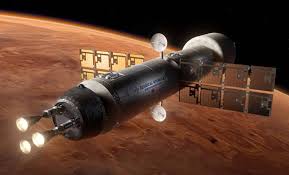
Exploring Mars has been a dream of scientists and space enthusiasts for decades, but reaching the Red Planet safely and efficiently remains a huge challenge. One solution gaining traction is nuclear propulsion, a technology that could make deep-space travel faster, safer, and more sustainable.
1. What Is Nuclear Propulsion?
Nuclear propulsion uses nuclear reactions to generate thrust for spacecraft. Unlike traditional chemical rockets, which burn fuel to create force, nuclear propulsion can:
- Provide continuous thrust over long durations.
- Reach higher speeds, reducing travel time between planets.
- Increase payload capacity, allowing more equipment and supplies to be carried.
There are two main types:
- Nuclear Thermal Propulsion (NTP): Heats a propellant like hydrogen using a nuclear reactor.
- Nuclear Electric Propulsion (NEP): Uses nuclear energy to generate electricity that powers ion engines.
2. Why Mars Missions Need Nuclear Propulsion
- Reduced travel time: Faster trips mean less exposure to cosmic radiation and microgravity for astronauts.
- Efficiency: Nuclear propulsion is more fuel-efficient, reducing the amount of fuel spacecraft must carry.
- Greater payloads: More scientific instruments, habitats, and life support systems can be transported.
- Mission flexibility: Allows for mid-course adjustments and safer landings.
Current chemical rockets can take six to nine months to reach Mars, while nuclear propulsion could cut that time significantly, making human missions more feasible.
3. Real-World Development
- NASA is actively researching NTP for future crewed Mars missions.
- Private companies and international space agencies are exploring nuclear-electric propulsion for long-duration missions.
- Prototype reactors and test engines have already been developed to demonstrate safety and performance.
These efforts indicate that nuclear propulsion is moving from theory to practical application.
4. Challenges and Considerations
- Safety concerns: Launching nuclear material requires extreme precautions to avoid accidents.
- Radiation shielding: Spacecraft must protect astronauts from reactor emissions.
- Technical complexity: Building reliable, lightweight, and efficient reactors is a major engineering challenge.
- Regulatory hurdles: International laws govern the use of nuclear technology in space.
Despite these challenges, the benefits of nuclear propulsion make it the leading candidate for interplanetary missions.
5. The Future of Mars Travel
Nuclear propulsion could enable:
- Shorter, safer trips for astronauts to Mars and back.
- Permanent human presence on Mars with more sustainable supply chains.
- Deep-space exploration beyond Mars, opening possibilities for missions to Jupiter’s moons, asteroids, and beyond.
By providing consistent, long-duration thrust, nuclear propulsion addresses many limitations of current chemical rockets, bringing ambitious space missions closer to reality.
Final Thoughts
The dream of human colonization of Mars depends on overcoming the limitations of conventional propulsion. Nuclear technology offers a solution that combines speed, efficiency, and power, making it essential for the next era of interplanetary exploration.